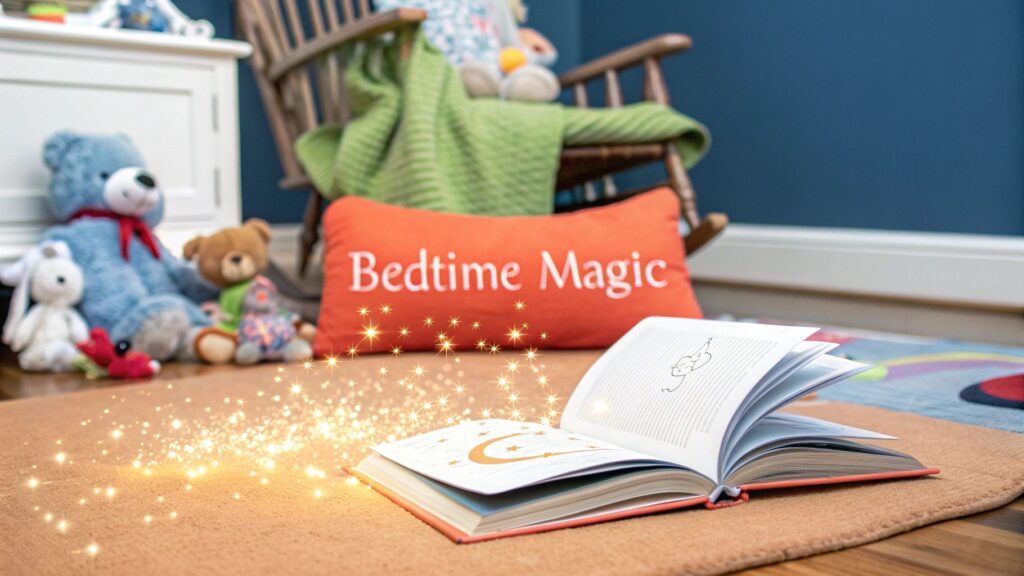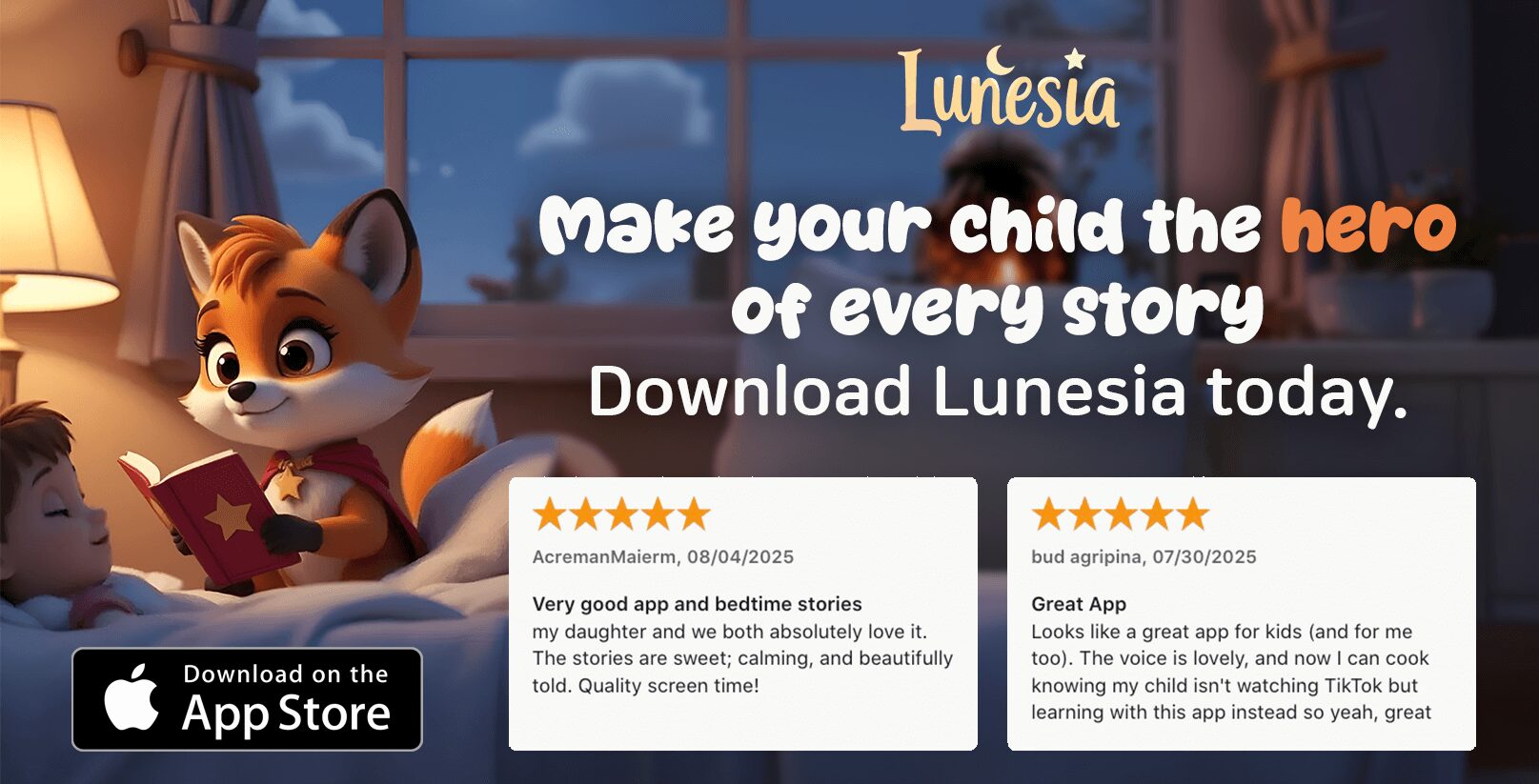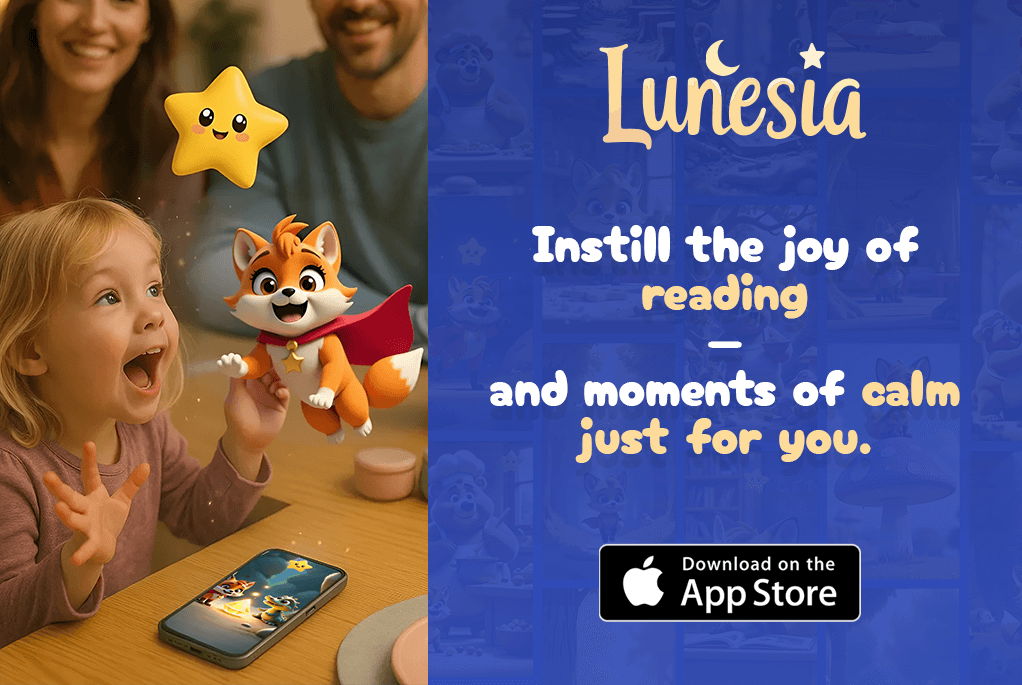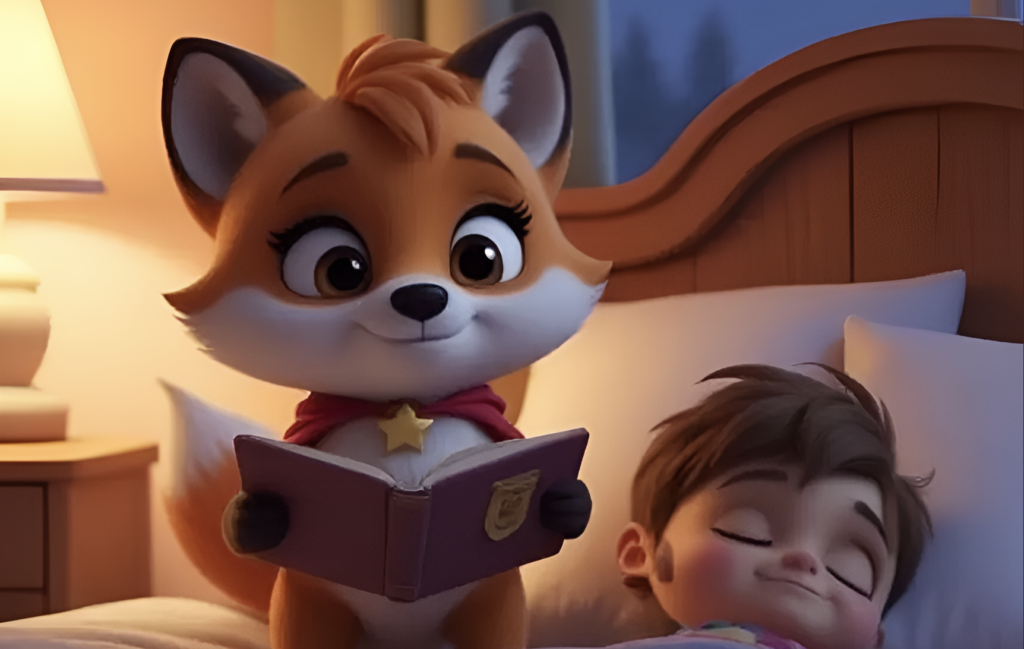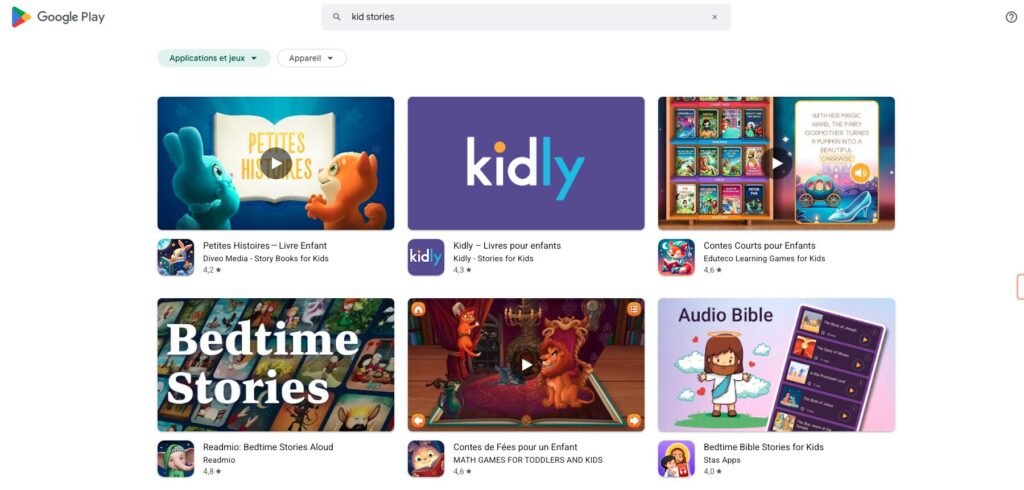Is that 8 PM countdown feeling less like quiet time and more like a nightly negotiation? You’re not alone. What if you could transform bedtime from a stressful showdown into a moment of magical connection? The secret isn’t just about getting them to close their eyes. It’s about calming their busy minds, soothing their hidden worries, and filling their dreams with wonder. A consistent bedtime routine is your superpower, and a captivating story is its cornerstone.
So, how do you pick the right one? We've curated a list of the most enchanting bedtime stories for 4-year-olds that do more than just entertain. These tales build resilience, spark imagination, and create a calm, loving end to the day. But what if storytime could be even more powerful? Imagine an app like Lunesia, where your child doesn't just listen—they make choices that shape the adventure. These aren't just bedtime stories; they're engaging journeys that teach kindness, courage, and empathy in a safe, ad-free world. This not only builds their confidence but gives you precious, guilt-free time while they embark on meaningful quests. Ready to turn the page on bedtime struggles? Beyond the magic of stories, exploring other proven tips to help them fall asleep faster can further enhance their bedtime routine.
1. Goodnight Moon by Margaret Wise Brown
Ever wonder why a simple story about a bunny saying goodnight has been a bedtime ritual for over 75 years? Goodnight Moon isn't just a book; it's a powerful sleep-aid, a masterclass in winding down the busy mind of a preschooler. Its magic lies in its predictability and soothing repetition, creating a gentle descent into dreamland that makes it one of the most effective bedtime stories for 4 year olds.
The story follows a young rabbit in a "great green room," methodically bidding farewell to every familiar object: the red balloon, the picture of the cow jumping over the moon, and even the "quiet old lady whispering 'hush'." As the pages turn, Clement Hurd’s illustrations subtly darken, mirroring the dimming light of evening and signaling to your child that it's time for rest. This visual and verbal cue system is incredibly grounding for a 4-year-old navigating the transition from a bustling day to a quiet night.

Why It Works So Well for This Age
A 4-year-old’s world is expanding rapidly, which can sometimes feel overwhelming, especially at bedtime. Goodnight Moon provides a sense of control and order. By saying goodnight to each object, the bunny is performing a closing ritual, and your child gets to participate in that predictable sequence. This process acknowledges and validates their environment, making their own room feel safe and secure. It transforms bedtime from a separation into a peaceful, shared activity.
Actionable Tips for Parents
Ready to make this classic even more effective? Here’s how you can turn storytime into a calming sensory experience tonight:
- Match Your Voice to the Story: Start with a normal, warm tone. As the rabbit says goodnight and the illustrations darken, gradually lower your voice to a soft whisper. This vocal cue is a powerful signal for your child’s body to relax.
- Dim the Lights with the Pages: If you have a dimmer, slowly turn it down as you progress through the book. This creates a multi-sensory experience that reinforces the message of "goodnight."
- Create Your Own "Goodnight" Ritual: After finishing the book, walk around your child’s room and encourage them to say goodnight to their own favorite things: "Goodnight, teddy bear. Goodnight, race cars. Goodnight, window."
- Let Them Participate: Once your child is familiar with the story, pause and let them fill in the blanks. Hearing them say "…and a quiet old lady who was whispering 'hush'" builds their confidence and deepens their connection to the ritual.
By incorporating these practices, you're not just reading a book; you're actively teaching your child how to self-soothe and transition to sleep. The profound impact of a consistent, calming narrative helps build a foundation for healthy sleep habits. You can discover more on the science behind how bedtime stories improve sleep quality and create lasting bedtime peace.
2. The Going to Bed Book by Sandra Boynton
What if getting ready for bed felt less like a chore and more like a playful, rhyming party on a boat? That's the delightful premise of Sandra Boynton's The Going to Bed Book. This board book transforms the mundane bedtime routine into a silly, rhythmic adventure, making it a brilliant choice among bedtime stories for 4 year olds who might be resisting the nightly wind-down.
The story follows a charming cast of animal characters aboard a boat as they go through the familiar steps of getting ready for sleep. They brush their teeth, put on their pajamas, and even do some last-minute exercises on the deck. Boynton's signature bouncy rhymes and whimsical illustrations turn a potentially stressful transition into a joyful, predictable sequence, reframing bedtime as a fun and necessary part of the day.

Why It Works So Well for This Age
A 4-year-old thrives on routine but often tests boundaries, especially when it comes to bedtime. The Going to Bed Book mirrors their own nightly rituals in a fun, pressure-free context. Seeing a hippo, a pig, and a moose all brushing their teeth together makes the activity feel communal and less like a parental command. This playful approach helps diffuse potential power struggles and empowers your child to follow along with the animals, turning them into a willing participant in their own bedtime process.
Actionable Tips for Parents
Ready to make this silly story a powerful part of your routine tonight? Here’s how to bring the boat-rocking fun into your home:
- Act It Out Together: When the animals take a bath, pretend to scrub. When they brush their teeth, make brushing motions. When they exercise, get up and do a few gentle stretches together before snuggling back into bed.
- Give Each Animal a Voice: Use a deep voice for the moose, a squeaky one for the pig, and a gentle one for the bunny. This simple act of characterization makes the story more engaging and hilarious for a preschooler.
- Follow the Book's Order: After reading, guide your child through their own bedtime routine in the exact same sequence as the book: bath, pajamas, teeth, then bed. This reinforces the pattern and makes it feel like you're continuing the story's game.
- Enjoy a Visual Read-Aloud: Sometimes, seeing the story come to life can add a new layer of engagement. Watch a video version together before reading the physical book to help them connect with the characters.
By turning the bedtime routine into an interactive performance, you’re not just reading a story; you’re creating positive associations with sleep and building joyful memories together.
3. Llama Llama Red Pajama by Anna Dewdney
Does your child’s sweet “goodnight” quickly turn into worried calls for you from down the hall? For many 4-year-olds, the moment the lights go out can trigger a wave of anxiety. Llama Llama Red Pajama tackles this exact scenario with empathy and charm, validating your child's big feelings while providing a comforting resolution. It’s one of the most essential bedtime stories for 4 year olds who experience separation anxiety.
The story follows a distressed Baby Llama who calls out for his mother after she goes downstairs. His small whimpers escalate into a full-blown "llama drama," a moment every parent recognizes. Author Anna Dewdney’s brilliant rhyming text captures the rising panic perfectly. This powerful narrative gives children the language and context to understand their own bedtime worries, and shows them they aren’t alone in feeling this way.
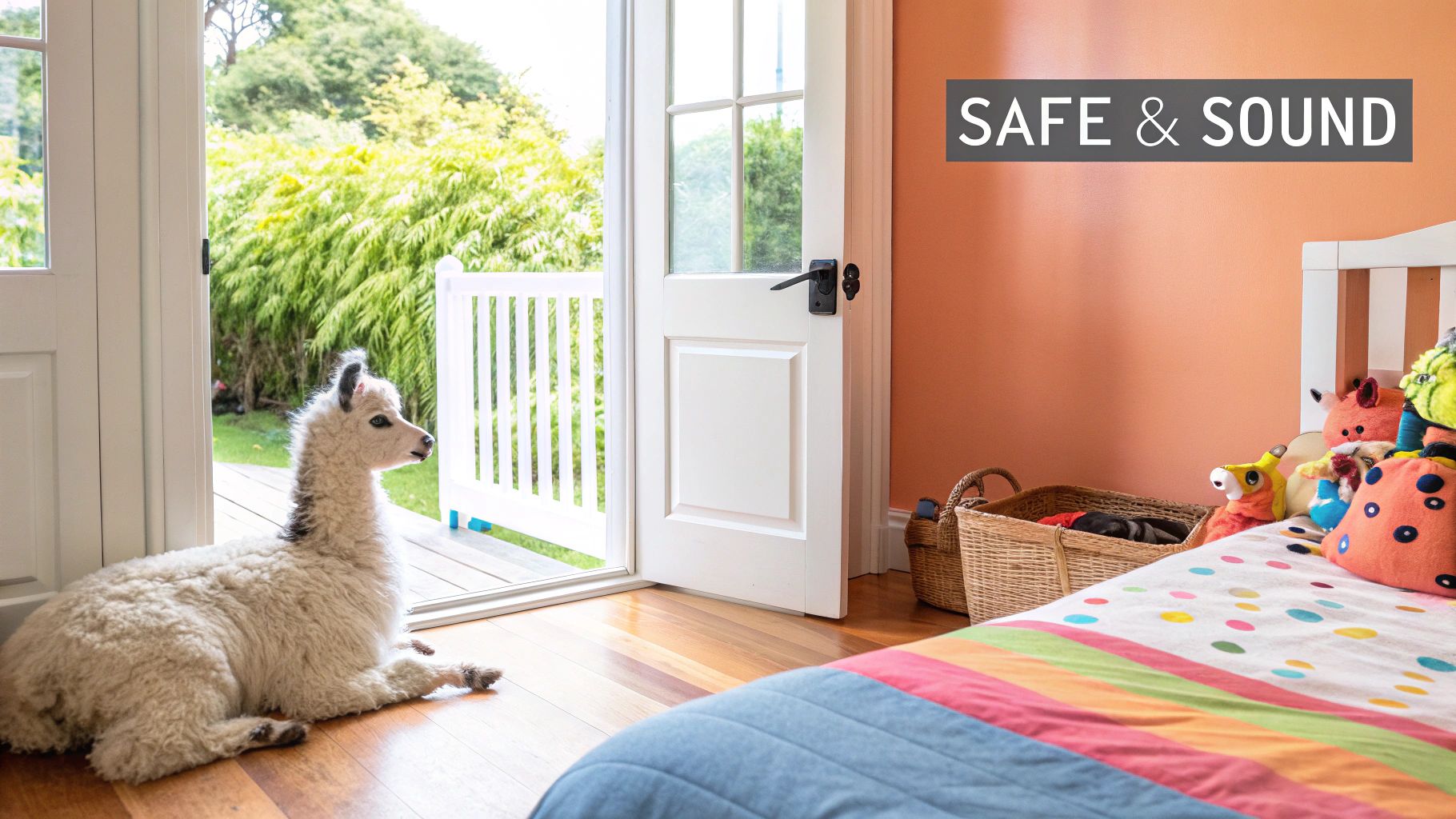
Why It Works So Well for This Age
A 4-year-old is developing a stronger sense of self, but they still heavily rely on you for security. When you leave the room, their imagination can run wild. Llama Llama directly addresses their core fear: "Will you come back?" The book’s resounding message, delivered by a loving Mama Llama, is "Mama Llama's always near, even if she's not right here." This simple, powerful line becomes a mantra that helps rewire your child's anxious thoughts, providing a sense of safety that lasts long after the book is closed.
Actionable Tips for Parents
Ready to turn this story into a powerful tool against bedtime battles? Try these concrete steps tonight:
- Acknowledge and Name the Feeling: While reading, pause and say, "Baby Llama feels worried right now. Do you ever feel worried when I leave the room?" This opens the door for your child to share their own anxieties without shame.
- Establish a "Check-In" Plan: Use the story to create a predictable routine. Say, "Just like Mama Llama came back, I will come check on you in five minutes." This gives your child a concrete event to anticipate, reducing uncertainty.
- Create a Comfort Phrase: Adopt the book’s core message as your own. Before leaving the room, give your child a hug and whisper, "I'm always near, even if I'm not right here." Repetition builds security.
- Practice Calming Breaths: When Baby Llama is panicking, you can practice taking a deep "llama breath" together. Inhale slowly and exhale with a soft hum. This physical action gives your child a tangible tool to use when they feel overwhelmed.
By using this book as a conversation starter, you’re teaching emotional intelligence and resilience. For kids who crave more agency, Lunesia offers interactive bedtime stories that empower them to make choices and face challenges within a safe narrative, building the confidence to handle their own “llama dramas.”
4. The Napping House by Audrey Wood
What if a story could physically lull your child to sleep with its rhythm? The Napping House does just that. This book uses a cumulative tale structure, where each page adds a new sleepy character to a growing pile, creating a hypnotic and predictable cadence. It’s a beautifully illustrated journey that makes the idea of a peaceful, shared slumber feel inviting and safe.
The magic of this book is in its gentle, building repetition and Don Wood’s dreamy, blue-hued illustrations. This slow, predictable progression makes it one of the most comforting bedtime stories for 4 year olds. The rhythmic language acts like a literary lullaby, slowing down a child's breathing and heart rate as you read. It moves from a “dozing dog” to a “slumbering cat” in a way that naturally encourages a state of rest.

Why It Works So Well for This Age
A 4-year-old’s brain thrives on patterns. The cumulative nature of The Napping House is deeply satisfying for them. They quickly learn the repeating phrases and anticipate who will be added next, giving them a sense of mastery. This structure isn’t just engaging; it’s neurologically calming. The story provides a sense of order and resolution, ending not with chaos, but with a bright, happy morning, which can ease any anxieties about the night.
Actionable Tips for Parents
Transform this sleepy tale into a multi-sensory wind-down ritual with these simple techniques:
- Become the Rhythm: Read the book with a slow, rocking cadence. Emphasize the sleepy words like “snoozing,” “dozing,” and “slumbering” by drawing them out. Let your voice get progressively quieter as more characters fall asleep.
- Let Them Be the Storyteller: The repetition is perfect for listener participation. Pause before a recurring phrase like, "…on a slumbering cat," and let your child fill in the blank. This active involvement keeps them engaged while reinforcing the calming rhythm.
- Use Stacking Hand Gestures: Use your hands to show the pile growing. Start with one hand flat for the bed, then stack your other hand, a fist, and fingers on top as each character joins the nap. It’s a quiet, kinesthetic way to connect with the story.
- Point and Identify: As you read, point to each character in the illustrations. This helps your 4-year-old follow the sequence and reinforces object identification, turning a simple story into a gentle learning activity.
By using these tips, you leverage the book's inherent structure to actively guide your child toward a state of calm. You are demonstrating how to transition from an active state to a restful one, a crucial skill for healthy sleep development.
5. Where the Wild Things Are by Maurice Sendak
Ever feel like you’re living with a tiny, adorable dictator whose mood can turn on a dime? What happens when their big feelings become too much to handle? Maurice Sendak’s classic, Where the Wild Things Are, offers a brilliant answer. This book is more than a tale of mischief; it's a safe, imaginative exploration of anger and reconciliation. It validates a child’s intense emotions, showing them that even after a "wild rumpus," a warm supper and unconditional love are waiting.
The story follows Max, who is sent to his room after causing chaos. His room transforms into a jungle, he sails to an island, and he tames the fearsome "Wild Things," becoming their king. Yet, he eventually feels lonely and sails back home to the comfort of his bedroom, where his dinner is waiting for him, still hot. This powerful narrative assures children that home is a secure base they can always return to, no matter how wild their feelings get.
Why It Works So Well for This Age
Four-year-olds experience hurricane-force emotions they can’t yet name. Where the Wild Things Are gives them a vocabulary for these feelings. It shows that anger is normal but doesn't have to be permanent. Max processes his frustration through his imagination, gains control, and chooses to return to the safety of his family’s love. This journey teaches emotional regulation in a way that is empowering, not punitive. It’s a masterful story that says, “I love you even when you’re a little wild.”
Actionable Tips for Parents
Ready to tame the wild things in your own home? Here’s how to make this story a tool for emotional growth:
- Let the Rumpus Start (Quietly): When you get to the "wild rumpus," encourage your child to make silly monster faces or wiggle their body under the covers. It’s a quiet way to get the wiggles out and physically release tension from the day.
- Talk About the "Why": Ask simple, open-ended questions. "Why do you think Max was so angry at his mom?" or "Have you ever felt like a Wild Thing?" This connects the story to their own life, helping them build self-awareness.
- Focus on the Return: When Max sails home, emphasize the change in his feelings. Say, "He was the king, but he wanted to be somewhere where someone loved him best of all." Reinforce the message that home is always a place of comfort and love.
- Create Your Own "Safe Harbor": After the story, talk about what makes your child feel safe and loved. End the night by reminding them that no matter what big feelings they have, your love is always waiting for them, just like Max’s hot supper.
6. The Very Hungry Caterpillar by Eric Carle
Did you know one of the most popular daytime books is also a secret weapon for bedtime? Eric Carle’s iconic tale of transformation, The Very Hungry Caterpillar, follows a tiny caterpillar on his week-long feast, culminating in his rest and magnificent metamorphosis. Its predictable rhythm and gentle progression from a tiny egg to a beautiful butterfly offer a comforting narrative arc, making it a powerful choice among bedtime stories for 4 year olds.
The story’s genius lies in its structure. It combines counting, days of the week, and food identification into a simple, repetitive journey. The climax isn’t a burst of action but a quiet retreat into a cocoon—a perfect metaphor for snuggling into bed. The final, awe-inspiring reveal of the butterfly provides a sense of peaceful closure and positive resolution, leaving your child feeling content and ready for their own restful transformation into a new day.
Why It Works So Well for This Age
For a 4-year-old, the concept of growth can be abstract. This book makes it tangible and beautiful. The caterpillar’s journey validates their own growing appetite for food and knowledge. More importantly, the caterpillar’s need for rest in its cocoon directly mirrors your child's need for sleep. It frames rest not as an ending to the fun, but as a necessary and wonderful part of becoming something more. This connection provides a powerful, positive association with bedtime.
Actionable Tips for Parents
Ready to unlock the bedtime potential of this classic? Try these simple shifts tonight:
- Shift the Focus to the Finale: Keep the pace upbeat while he's eating, but when the caterpillar gets a stomachache and eats the green leaf, begin to slow down. Use a softer, more hushed tone as you describe him building his cocoon.
- Connect the Cocoon to Bed: When the caterpillar is in his cocoon, say something like, "He’s all cozy and warm in his little bed, just like you are now. He’s resting so he can become a beautiful butterfly." This draws a direct, comforting parallel.
- A "Good Morning" Butterfly: End the story on a gentle, wondrous whisper about the butterfly. You can save the "big reveal" voice for the next morning, saying, "Good morning, my beautiful butterfly!"
- Let Them Be the Caterpillar: Encourage your child to munch along with the caterpillar (without food, of course!) and then snuggle up tight like he’s in a cocoon when the time comes. This physical participation helps them internalize the message of rest.
7. Time for Bed by Mem Fox
What if a story could feel like a warm, gentle hug? Mem Fox’s Time for Bed achieves just that. This book is a tender, lyrical journey through the animal kingdom, where parent after parent lovingly tucks their little one into bed. Its universal message of comfort and safety makes it one of the most reassuring bedtime stories for 4 year olds.
The magic of this book lies in its soft, rhyming couplets and Jane Dyer’s dreamy illustrations. From a mother sheep nuzzling her lamb to a father goose nestling with his goslings, each page reveals another scene of parental affection. The refrain, "It's time for bed, little…" creates a predictable and calming cadence, signaling that sleep is a peaceful and cherished part of the day for all creatures. This gentle repetition helps quiet a busy preschooler's mind, easing anxieties about separation.
Why It Works So Well for This Age
A 4-year-old is deeply connected to you, and bedtime can sometimes feel like a moment of separation. Time for Bed directly addresses this by reinforcing the unbreakable bond of love and security. Seeing various animal parents tenderly caring for their young validates your child's own experience and makes them feel safe and treasured. The story's rhythm mimics a lullaby, physically calming their nervous system and preparing their body for rest.
Actionable Tips for Parents
Ready to make this soothing story even more impactful? Here’s how to wrap your child in the book's comforting embrace:
- Embrace a Lullaby Pace: Read the story very slowly, almost like you’re singing a soft song. Let your voice be gentle and quiet, allowing the natural pauses in the rhythm to create moments of peaceful silence.
- Point Out the Love: As you read, point to the baby animals and their parents. Use phrases like, "Look how that mommy sheep is hugging her baby," to highlight the expressions of affection on each page.
- End with a Snuggle: The story culminates with a human mother tucking in her child. Use this as your cue to mimic the action. End the reading with extra snuggles, kisses, and a soft whisper, just like the parents in the story.
- Make It the Grand Finale: Because of its profoundly calming nature, use Time for Bed as the very last story before lights out. It serves as the final, peaceful transition from the waking world to dreamland.
This book doesn't just tell a story; it creates an atmosphere of deep tranquility. By weaving this narrative into your nightly routine, you are teaching your child that bedtime is a time of safety and love. For more ideas on creating calm, you can explore other quiet time activities for preschoolers to help wind down the day.
Top 7 Bedtime Stories Comparison
| Title | Implementation Complexity 🔄 | Resource Requirements ⚡ | Expected Outcomes 📊 | Ideal Use Cases 💡 | Key Advantages ⭐ |
|---|---|---|---|---|---|
| Goodnight Moon | Low – simple repetitive text and illustrations | Low – standard printed or digital copy | Calming bedtime routine, aids sleep transition | Bedtime routines for ages 3-5 | Proven soothing, predictable, encourages mindfulness |
| The Going to Bed Book | Low – rhyming text, simple scenes | Low – sturdy board book format | Makes bedtime fun, models routines | Toddlers learning bedtime habits | Durable, engaging rhythm, encourages participation |
| Llama Llama Red Pajama | Medium – rhyming text with emotional themes | Low to medium – print or animated | Helps address separation anxiety, emotional processing | Children with bedtime fears | Validates emotions, strengthens parent-child bond |
| The Napping House | Medium – cumulative story structure | Low – print with detailed illustrations | Enhances memory/sequencing, induces sleepiness | Storytime focusing on cause/effect | Soothing repetition, award-winning illustrations |
| Where the Wild Things Are | High – rich, complex narrative | Medium – detailed illustrations | Emotional intelligence, imaginative exploration | Kids processing big emotions | Classic literary value, emotional depth |
| The Very Hungry Caterpillar | Low – simple pattern, interactive | Low – tactile board book/digital apps | Combines learning and storytelling, comfort | Early learning and bedtime routines | Educational, tactile engagement, familiar and comforting |
| Time for Bed | Low – simple rhyming text | Low – lightly illustrated print | Creates calm, sleep-ready environment | Soothing bedtime transitions | Gentle rhythm, universal message of safety |
Beyond the Page: Create Your Own Adventures & Reclaim Your Evenings
Feeling more equipped to handle the bedtime countdown? We've journeyed through timeless classics, from the soothing rhythm of Goodnight Moon to the emotional validation in Llama Llama Red Pajama. Each book offers a unique gateway to sleep, helping calm busy minds, tackle big emotions, and build a love for reading. The core takeaway is clear: the right story doesn't just end the day; it shapes it.
The books on our list are powerful tools for establishing a comforting routine. Think of the giggles over Sandra Boynton’s silly animals or the quiet awe inspired by Eric Carle's butterfly. These shared experiences are the bedrock of a secure and loving parent-child bond.
But what if you could take that connection a step further? What if your child didn't just listen to the story but became its hero?
From Passive Listener to Active Hero
The true power of storytelling is unlocked when a child sees themselves in the narrative. Imagine your four-year-old making a decision that helps a lost star find its way home or choosing an act of kindness that changes the story’s outcome. This isn't just entertainment; it's a developmental powerhouse.
Research shows that active participation deepens learning and boosts confidence. In fact, a study published in the Journal of Applied Developmental Psychology found that interactive storytelling can improve children's executive functions. When children make choices and see the consequences in a safe, fictional world, they are practicing critical life skills:
- Problem-Solving: Deciding how to help a character in a story builds the same mental muscles needed to solve a puzzle or share a toy.
- Empathy: Choosing to be kind to a grumpy giant teaches them to consider others' feelings in their own friendships.
- Emotional Resilience: Navigating a story's challenges helps them process their own fears and anxieties, building a toolkit for real-life situations.
This is precisely where Lunesia transforms the nightly routine. Our interactive adventures are designed to turn passive listening into active engagement. Instead of just hearing about bravery, your child practices it. And the bonus for you? While they are engrossed in a meaningful quest, you get something equally valuable: a moment of peace. You can finally put your feet up or simply breathe, all without a shred of guilt. You know they aren't just occupied; they are growing, learning, and becoming the hero of their own story.
Choosing the perfect bedtime stories for 4 year olds is about more than just finding a book; it’s about creating an experience. It’s about building a bridge to dreamland paved with imagination, confidence, and love.
Ready to transform your child's bedtime from a routine into an empowering adventure? Download Lunesia today and watch them become the hero of their own story, making choices that build confidence and kindness. Give them a universe of interactive tales and give yourself the gift of guilt-free peace. Explore the magic at Lunesia.
